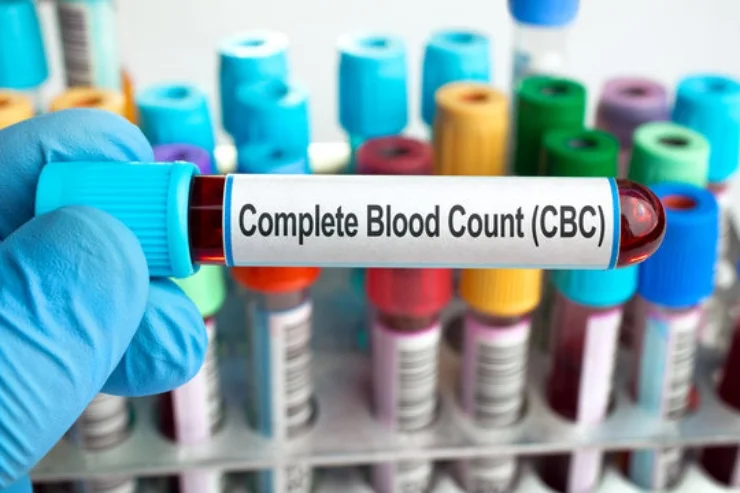Complete Blood Count (CBC)

A Complete Blood Count (CBC) is a comprehensive blood test that provides important information about the levels and types of cells in the blood, including red blood cells (RBCs), white blood cells (WBCs), and platelets. It is one of the most common and frequently ordered diagnostic tests in clinical practice. A CBC helps in assessing a person’s overall health and diagnosing a variety of conditions, such as anemia, infection, and many other diseases.
Components of a Complete Blood Count (CBC):
Red Blood Cell (RBC) Count:
- Function: RBCs carry oxygen from the lungs to the tissues and return carbon dioxide to be expelled from the body.
- Normal Values: The normal range varies by age and gender. In general, adult men have an RBC count of about 4.7 to 6.1 million cells per microliter (cells/µL), while adult women have a range of 4.2 to 5.4 million cells/µL.
Hemoglobin (Hb):
- Function: Hemoglobin is the protein in RBCs that binds to oxygen and carries it throughout the body.
- Normal Values: Adult men: 13.8 to 17.2 grams per deciliter (g/dL), and adult women: 12.1 to 15.1 g/dL.
- Abnormalities: Low hemoglobin levels are indicative of anemia, whereas high levels can be seen in conditions like chronic obstructive pulmonary disease (COPD) or high altitudes.
Hematocrit (Hct):
- Function: Hematocrit measures the proportion of blood that is made up of RBCs. It reflects the volume of RBCs compared to the total blood volume.
- Normal Values: Adult men: 40.7% to 50.3%, and adult women: 36.1% to 44.3%.
- Abnormalities: Low hematocrit values suggest anemia, while high levels could indicate dehydration or polycythemia.
White Blood Cell (WBC) Count:
- Function: WBCs are part of the immune system and help the body fight infection and disease. A WBC count helps assess immune function and identify infections, inflammation, or blood disorders.
- Normal Values: 4,500 to 11,000 cells/µL.
- Abnormalities: An increased WBC count can indicate an infection, inflammation, or leukemia, while a low count may suggest bone marrow problems, viral infections, or an autoimmune disease.
Platelet Count:
- Function: Platelets are small cells that help in blood clotting and wound healing. They aggregate to form clots and stop bleeding.
- Normal Values: 150,000 to 450,000 platelets/µL.
- Abnormalities: A low platelet count, known as thrombocytopenia, can lead to excessive bleeding, while a high platelet count, known as thrombocytosis, may increase the risk of blood clotting and cardiovascular issues.
Mean Corpuscular Volume (MCV):
- Function: MCV measures the average size of red blood cells. It helps to classify anemias and other blood disorders.
- Normal Values: 80 to 100 femtoliters (fL).
- Abnormalities: A high MCV indicates macrocytic anemia, often caused by vitamin B12 or folic acid deficiency. A low MCV suggests microcytic anemia, often seen in iron deficiency anemia.
Mean Corpuscular Hemoglobin (MCH):
- Function: MCH measures the average amount of hemoglobin in a single red blood cell.
- Normal Values: 27 to 31 picograms (pg) per cell.
- Abnormalities: Low MCH is commonly seen in iron deficiency anemia, while high MCH can be found in macrocytic anemia.
Mean Corpuscular Hemoglobin Concentration (MCHC):
- Function: MCHC measures the concentration of hemoglobin in a given volume of red blood cells. It provides information on the color of RBCs.
- Normal Values: 32 to 36 g/dL.
- Abnormalities: Low MCHC is typical in hypochromic anemia, and high MCHC may indicate spherocytosis or other RBC membrane disorders.
Red Cell Distribution Width (RDW):
- Function: RDW measures the variation in the size of red blood cells. It helps in differentiating between different types of anemia.
- Normal Values: 11.5% to 14.5%.
- Abnormalities: A high RDW is seen in iron deficiency anemia, vitamin B12 deficiency, and other nutritional anemias.
Clinical Uses of CBC:
- Diagnosis of Anemia: A CBC can help diagnose various types of anemia, such as iron deficiency anemia, vitamin B12 deficiency anemia, or hemolytic anemia.
- Monitoring Infections: An elevated WBC count typically suggests the presence of an infection or inflammation.
- Evaluating Bleeding Disorders: The platelet count helps assess the risk of bleeding or clotting disorders, such as thrombocytopenia or thrombocytosis.
- Cancer Diagnosis: A CBC can help in the diagnosis and monitoring of cancers such as leukemia or lymphoma, which often affect blood cell counts.
- General Health Check: A CBC is often part of routine health check-ups to detect early signs of health issues that may not yet present noticeable symptoms.
Conclusion:
The Complete Blood Count (CBC) is a fundamental and widely used diagnostic test that provides a snapshot of a patient’s overall health and helps detect a variety of medical conditions, ranging from infections and anemias to more serious diseases such as cancers. Abnormal results in any of the components of the CBC often prompt further investigations to determine the underlying cause and guide appropriate treatment.



